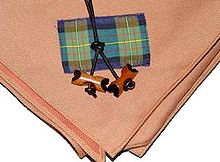- Neckerchief
-
A neckerchief, necker or less commonly scarf is a type of neckwear associated with Scouts, cowboys and sailors. It consists of a triangular piece of cloth or a rectangular piece folded into a triangle. The long edge is rolled towards the point, leaving a portion unrolled. The neckerchief is then fastened around the neck with the ends either tied or clasped with a slide or woggle.
Contents
Wearing of neckerchiefs
Neckerchiefs worn by sailors are shaped like a square, and are folded in half diagonally before rolling, with rolling occurring from the tip of the resulting triangle to its hypotenuse. Either neckerchief is then placed on the wearer's back, under or over the shirt collar with the ends at the front of the wearer. The rolled ends then pass around the neck until they meet in front of it, where they are secured together, either with a knot, such as a reef knot or a slip knot, or with a rubber band or other fastener (called a woggle or neckerchief slide) and allowed to hang. It is best to use a slip knot as a simple reef or square knot will not give way if the neckerchief gets caught and thus can potentially choke the wearer.
In the United States Navy; solid black neckerchiefs are currently part of the men's service dress uniform for junior enlisted sailors as well as the women's summer dress uniform.
Scouting
The Scouting movement makes the neckerchief part of its uniform. A generally ceremonial item, the neckerchief is taught to be a practical wilderness item in the Scouting tradition. The neckerchief, unrolled, is designed to be the perfect size for use as a triangular bandage for first aid.
In most countries each Scout Troop uses its own colour neckerchief. The colours are usually the "Troop Colours" which may have a particular historical significance to the troop or to the local community.
In Canada, while most groups use colour neckerchiefs, there is also an optional alternate universal pattern tartan neckerchief: white plaid on red for Scouts, gold plaid on dark green for Cubs. Alternating thick and thin lines of the plaid spell out "CANADA" in Morse code.
In Australia, Queensland uses a single maroon necker for the whole state, while the other states allow groups, Venturer Units and Rover Crews to choose their own necker. Region and Branch Teams also have their own neckers.
In Hungary, as well as the Hungarian diaspora communities in countries such as the U.S.A., the necktie color is national rather than distinctive for each troop, being light blue for ages 10 and younger and grass green for ages 11 and up.
In other countries individual patrols are identifiable by their neckerchiefs and so troops may have many different neckerchiefs all at once. In both of these cases the neckerchief and its colours are an issue of identity, and become emblematic of a troop or a patrol.
Neckerchiefs can also have important ceremonial functions in Scouting, for example, the 1st Gilwell Scout Group present a special neckerchief on completion of the Wood Badge.
See also
External links
References
Categories:- Scarves
- Scouting uniform
Wikimedia Foundation. 2010.


